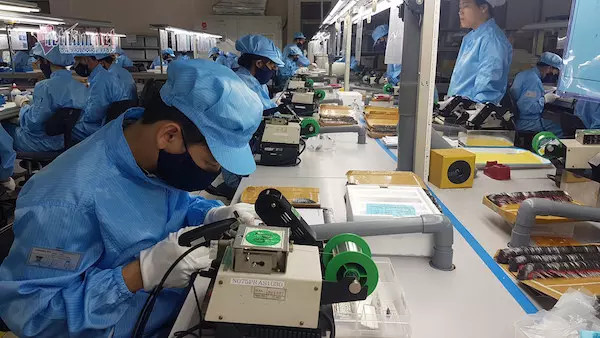
Vaccine – the decisive factor
Deputies will gather at the National Assembly Building in Hanoi. This means that National Assembly’s activities will return to the usual way, which was not seen at the sessions in 2019 because of Covid-19.
This, plus the new normal of the whole economy and society in general, is the result of vaccination coverage, a great effort by the Government.
A Government report showed that as of the end of 2021, Vietnam had injected over 152 million vaccine doses, including 132 doses for people aged 18 and higher (99.5 percent of them had got at least one dose and 90.7 percent had basic doses).
From a country slow in approaching vaccines, Vietnam has become one of the countries with the largest coverage of vaccine in the world. It has reached at least 70 percent of population with basic doses as recommended by WHO six months earlier than expected.
On that basis, Vietnam’s anti-pandemic policies have shifted to ‘safe adaptation’ to the pandemic, allowing socio-economic activities to come to the normal track.
However, a lot of problems have arisen, especially in the context of the dark clouds hovering over the world’s economy with record high inflations, interrupted food supply and starvation in many places in the world.
Which color is the picture of the world’s economy?
It is necessary to define which color the picture of the world’s economy is so as to find reasonable solutions.
Why are the state budget collections very high while the economy, businesses and people are having big difficulties after the pandemic?
The Government reported that the total budget collections in 2021 were much higher than estimates (increasing by 16.8 percent), or VND203 trillion higher than the figure reported to the National Assembly in October 2021 (increasing by VND22.2 trillion only compared with the estimates). The budget revenue in the first 4 months of the year was nearly 47 percent of the estimates, up more than 15 percent over the same period last year.
This is abnormal in the context of the lowest growth rate of the national economy in the last many decades due to Covid-19. As of the first quarter this year, as many as 16.9 million people aged 15 and higher had lost their jobs, had to reduce working hours, and worked under rotation scheme with revenue decreasing.
In 2021 alone, nearly 120,000 businesses had to suspend their business, operations and become dissolved. The tourism, accommodation, food, passenger transport and preschool education sectors all had serious difficulties and many enterprises went bankrupt.
The difficulties of businesses are indisputable. However, the Government reported to the National Assembly that the investment of the non-state economic sector accounted for 59.5 percent of total social investment, a jump from the previous levels of just over 40 percent.
This is an inexplicable if noting that 23 cities/provinces were under lockdown in accordance with Directive 16 throughout the third quarter of 2021, the quarter with minus (-) 6.02 percent growth rate, the lowest level since the day Vietnam began releasing quarterly statistics.
While the national economy is facing difficulties and businesses are thirsty for capital, the state’s money is still in the treasury. The disbursement rate for public investment by the end of April was just equal to 18.5 percent of the yearly plan.
A report showed that 43 out of 51 ministries and 28 out of 63 localities had the disbursement rates of below 17 percent, while 17 ministries and central agencies had the disbursement rates of zero percent. There has been no improvement in the disbursement of foreign loans and only 3 percent has been implemented.
What does the high state budget collections show, if noting that people and businesses are in big difficulties, facing challenges in jobs, orders and capital access? The question needs clear explanation.
Drastic measures needed
The demand for capital and cash flow from businesses is very high. When asked if there is space for continued interest rate cuts, Governor of the State Bank of Vietnam Nguyen Thi Hong late last year predicted that there would be pressure on inflation in 2022.
A report of the Government showed that the balance-sheet bad debt ratio, the debts sold to the Vietnam Asset Management Company (VAMC) and the debts which may become bad debts account for 6.31 percent of total outstanding loans.
Only several days before the National Assembly’s session opening did the Government release guidance on the implementation of the 2 percent interest rate subsidy program. It seems that the Government was cautious when launching the package after learning the lesson from the 4 percent interest rate subsidy package worth $1 billion launched in 2009. The package then led to serious consequences in inflation.
As such, the inflation rate is at risk of increasing and the interest rate, therefore, won’t be able to decrease as expected. The CPI in April increased by 2.09 percent compared with the end of 2021, and nearly twice as much as the same periods of 2018-2021.
Meanwhile, the political and economic situation in the world is complicated: the conflict between Russia and Ukraine continues; the crude oil price and inflation rate are the highest in the last many years; some large economies have scaled down monetary policy loosening; the US FED has raised the prime rate for the first time since 2018; and the economic growth globally is slowing down.
What will the National Assembly do so, together with the Government, to create reasonable policies to continue to support people and businesses who are still in big difficulty after the pandemic?
Tu Giang